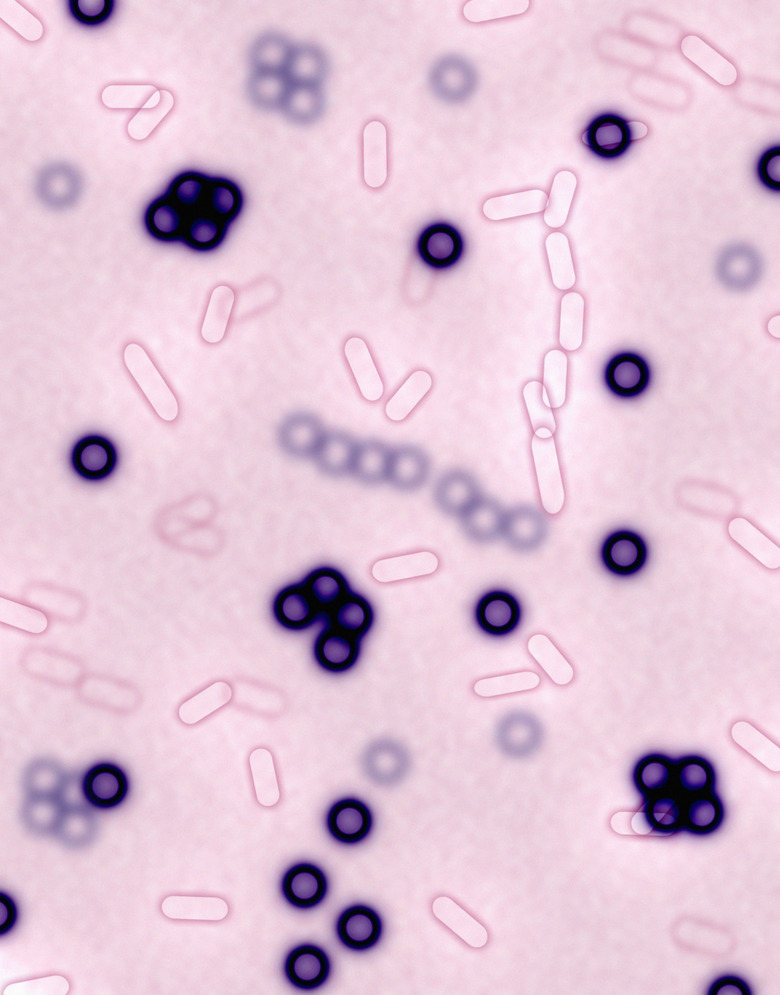What Is A Tetrad In Microbiology?
Microbiology is the study of life-forms so small that they usually can be viewed only through a microscope. These include bacteria, fungi, algae, viruses and protozoa. Bacteria and viruses are prokaryotic organisms, lacking a nucleus. Algae, fungi and protozoa are eukaryotes that have a nucleus. Structures called tetrads, which means "groups of four," exist in bacteria, fungi, algae and protozoans. The term refers to products of cell division in eukaryotes and of organism division in bacteria.
Bacteria
Bacteria
One-celled organisms that can range from 0.5 to over 100 micrometers in size, bacteria can be complex despite their small size and lack of a nucleus. Bacterial classification is based primarily on their shape. The three most common bacterial shapes are the round or oval coccus, the rod-shaped bacillus and bacteria with a spiral shape. The tetrad occurs in a subgroup of the cocci where the bacterium divides in two planes to form a square of four bacteria called a tetrad. Some examples of tetrad-forming bacteria are the lactic acid bacilli, Aerococcus, a urinary tract pathogen and Pediococcus and Tetragenococcus, both of which ferment foods.
Fungi
Fungi
Molds, yeasts and mushrooms all have tetrads in the spore-producing bodies they produce as part of sexual reproduction. When these fungi undergo meiosis, the result is four or eight spores contained within a sac-like fruiting body called an ascus (plural asci). Each of the spores has a haploid number of chromosomes, or half the number of the organism itself. Sometimes the four spores undergo a further mitotic division to produce eight spores, called octads, which are regarded as two sets of paired tetrads. Examples of fungi that produce tetrads are baker's yeast (Saccharomyces cerevisiae), green bread mold (Aspergillus nidulans), inky cap mushrooms (Coprinus lagopus) and the pathogen barley smut (Ustilago hordei).
Algae
Algae
Some algae also produce tetrads through the same process described for fungi. In both algae and fungi, if the tetrads and octads are lined up so their meiotic and mitotic origin can be determined, they are called linear or ordered tetrads. If the spores are randomly arranged, they are called unordered tetrads. Ordered tetrads are useful in genetics because each spore can be cultured separately and analyzed to get information on linkages and recombinations in meiosis through a process called tetrad analysis. Red algae and the green algae Chlamydomonas reinhardtii and Dunaliella spp. are examples of tetrad-producing algae.
Protozoans
Protozoans
The parasitic protozoan that causes the disease babesiosis (Babesia spp.) infects red blood cells. Different species attack livestock, wildlife and humans. Spread by tick bites, Babesia undergoes a complicated life cycle. The tick injects a sporozoite into the host animal. It migrates to a red blood cell, where it develops into the next stage, called a trophozoite. This then changes into a merozoite, which has a tetrad structure. The tetrad's unique form allows babesiosis to be distinguished from other blood-borne parasites such as malaria.
References
- Merriam-Webster: Dictionary: Microbiology
- Microbiology: Principles and Explorations; Jacquelyn G. Black
- Lactic Acid Bacteria; Seppo Salminen, Atte von Wright
- Biology of the Red Algae; Kathleen M. Cole and Robert G. Sheath
- Stanford University: Parasites: Babesia
- Biochemistry and Physiology of Protozoa, Volume 1; M. Levendowsky
- The Community College of Baltimore County: The Prokaryotic Cell: Bacteria: Sizes, Shapes, and Arrangements of Bacteria
Cite This Article
MLA
Csanyi, Carolyn. "What Is A Tetrad In Microbiology?" sciencing.com, https://www.sciencing.com/tetrad-microbiology-21759/. 24 April 2017.
APA
Csanyi, Carolyn. (2017, April 24). What Is A Tetrad In Microbiology?. sciencing.com. Retrieved from https://www.sciencing.com/tetrad-microbiology-21759/
Chicago
Csanyi, Carolyn. What Is A Tetrad In Microbiology? last modified August 30, 2022. https://www.sciencing.com/tetrad-microbiology-21759/
